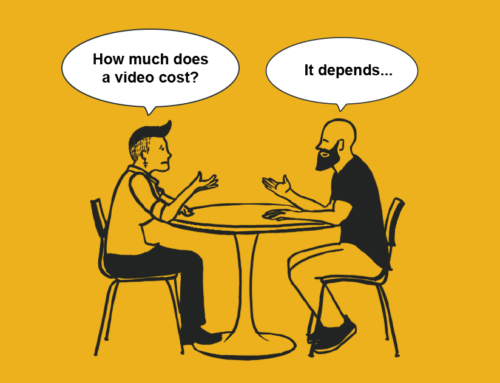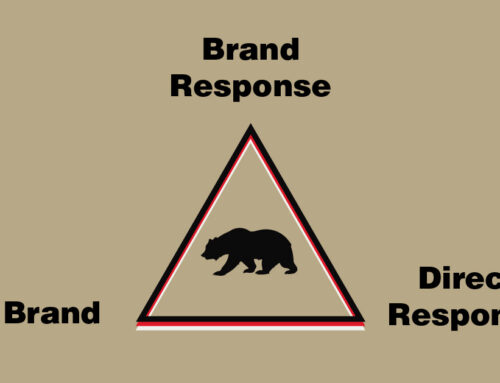Measuring the ROI of Video

Video is an investment in the growth of your company. So it needs to be able to deliver a Return On Investment(ROI). In this article I’m going to cover the keys metrics you need to use to measure the ROI of your video. But first things first…
Measuring ROI starts with your goals.
Your goals will usually include one or all of the following:
- Drive Traffic
- Increase Brand Awareness
- Generate Leads/Sales
Having goals makes it easier to measure the ROI metrics of your video through the right lens. Video ROI metrics fall into two major categories:
- Quantitative Metrics
- Qualitative Metrics
1. Quantitative Metrics
Quantitative metrics are the easiest to track since they’re backed by empirical data. They’re essentially the hard numbers on the performance of your video.
Engagement
- Clicks – how many times a person clicked on your video or CTA
- Impressions – amount of times your video was displayed
- Overall Views – How many times your video was watched
- Watch time – How long was your video watched before the person left
I’ll start with a warning – Do Not get too caught up in the clicks. Not getting your desired amount of clicks isn’t the end of the world. Impressions still matter. Remember, 95% of your buyers aren’t ready to buy right now. Shocking, I know.
The name of the game is to stay top-of-mind until your audience is ready to pull the trigger.
Overall views and watch time are both good ways to develop an understanding of what’s working within the video itself. It can help you hone in on the key areas that are resonating with audiences and provides valuable insights on how to adjust things.
Social Media Signals
- Likes
- Comments
- Shares
- New Subscribers
You know you’re doing something right when people engage with your video content on social media. The engagement metrics still apply but now you have the addition of social signals.
Social signals let you know where you’re making an impact in educating, informing, and/or entertaining your audience on popular platforms. Where you’ll really start to see ROI is by having an engagement plan to extract value from each of the social signals.
Tip: Use each social signal as permission to directly engage with the prospects. Having a plan for how to leverage your videos social signals is the key to measuring the ROI.
Percentage of Leads Generated
This is the ultimate goal.
One of simplest ways to directly track your ROI on Leads is to A/B test a landing page that includes a form. Run one landing page with a video and another without to see how effective your video actually is. Comparing your conversion rate should give you a better idea of your ROI.
Time & Resources Saved
Creating the right type of video can help you automate a part of, or your entire, sales pitch.
This ultimately plays a positive role in lowering your Customer Acquisition Cost(CAC). It starts with knowing how much time and resources go into pitching a lead and moving them through the funnel. Then calculate how much time and resources your video allows you to save.
2. Qualitative Metrics
This is the part that most people miss because it’s not tied to numbers. The best performing videos evoke emotion. Unfortunately, feelings are hard to track
One of the best ways to measure qualitative metrics is through conversation. When you do get on that call with your prospects, ask them what led them to you and helped in the decision making process. If it’s the video, make a note of what worked and add that impact to right qualitative metrics. Those metrics will usually come in the following forms:
Brand Love:
How are you becoming a preferred choice? Because when all the other factors are equal between you and the competition – the affinity a buyer has for your brand will be the difference. Video helps tremendously on the brand building front.
Trust:
As buyers go through their journey they ultimately need to build trust. They need to be nurtured from knowing you, to liking you, to ultimately trusting you. Video lets your personality shine through and is one of the most powerful tools in helping audiences build trust.
Education:
Video is one of the best ways to educate buyers. This is another way of saving time and resources while increasing the efficiency of product education. You have to ask yourself – how educated are your prospects when the engage with you in person? and how many man-hours were saved getting to that point?
Conclusion
Video is a powerful tool for your businesses growth with a history of creating positive ROI. But it takes using both quantitative and qualitative metrics together to paint a clear picture. By focusing on these metrics you can develop a deeper understanding of your audience and how video is impacting your company’s goals. Allowing you to use video more effectively in your growth strategy.

![Copywriting That Converts: 7 Frameworks [with Examples]](https://gnnrcompany.com/wp-content/uploads/2023/05/8BestCopywriting_Hero-500x383.png)

